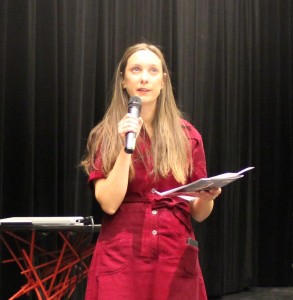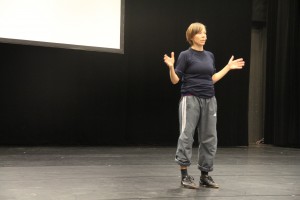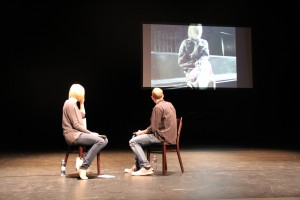The meaning of movement
The fifth and final seminar of the Norwgian Writing Movement seminars was held Sept 29th during the CODA Oslo International Dance Festival at Dansens Hus in Oslo. It was an extension of the dedicated seminar series for journalists, critics and editors that took place in the spring 2013, and was initiated as a desire for more people to be introduced to the ideas drawn up by Cecilie Lindemann Steens and Geir Gulliksens lectures during the spring sessions.
84 people came to the “The meaning of movement”-seminar, including dance artists, dance students, some journalists and festival audience with and interest in the topic. In the introduction Project manager for Writing Movement, Ine Therese Berg, presented the seminar’s main goals/purposes, which are simultaneously increased verbalization and increased visibility of the art of dance. Furthermore the audience got a quick introduction to the themes of the first four seminars.
What moves us – and how do we move?
The first lecture revisited and extended Cecilie Lindeman Steen’s work demonstration from the first session in the seminar series. Lindeman Steen has over 30 years of experience in dance and has been one of the most sought after dancers in Norway for several decades. Today she is educating the dance artists of tomorrow at the dance department at Oslo Academy of the Arts.
In her demonstration Cecilie highlighted renowned choreographers and performances contributions to the development of the art form and gave an insight both into how she works on communication as a dance artist, and what moves her as an audience member.
She asserted the inseparability of body and language and gave us, through her retrospects, a vocabulary to talk about communication and experience of dance.
How does the audiences’ body receive the dance? How can the choreographer and the dancer give the audience a truly remarkable experience? What resonates with the audience and how to create dynamics in the room? The dancer has different tools, like timing, direction, intension, focus, rhythm. Lindeman Steen believes that the movement must come from the inside, like states of emotions. Secondary elements are choices related to music, scenography and composition. The choices are endless and the totality of a performance is large and complex.
Seen from the outside, seen from the inside
After a break, Janne-Camilla Lyster and Geir Gulliksen continued to discuss the questions from Lindeman Steen in an on stage conversation: What is it in dance that moves and resonates with the audience? Geir Gulliksen is a writer and a publisher in the publishing house Oktober. Janne-Camilla Lyster has been successful both as a dancer, choreographer and writer.
“I have spoken a lot with Janne-Camilla Lyster (…). I went to her because I wanted to understand what she does, how some movements seem to be significant, expressive, interesting. Why, and where does it come from, that which she decides to use? We agreed on that the only way of solving this was me watching her work. (Geir Gulliksen)
A projector showed us short video clips where we could see Janne-Camilla Lyster dance in choreographer Eva Cecilie Richardsens piece “Speaking and Building”. Asked about her creative process Lyster told Gulliksen and the audience how she as a dancer and choreographer, with help from words and pictures, finds movement material or works her way into a character. They contemplated over what makes a gesture significant, meaningful and charged, both for the dancer and for the viewer. Gulliksen’s first question to Lyster was: how does a movement come to life? He has not yet been answered.
After the lecture the performance “Work-in-progress” with Thale Dolven & Taka Shamoto was show


